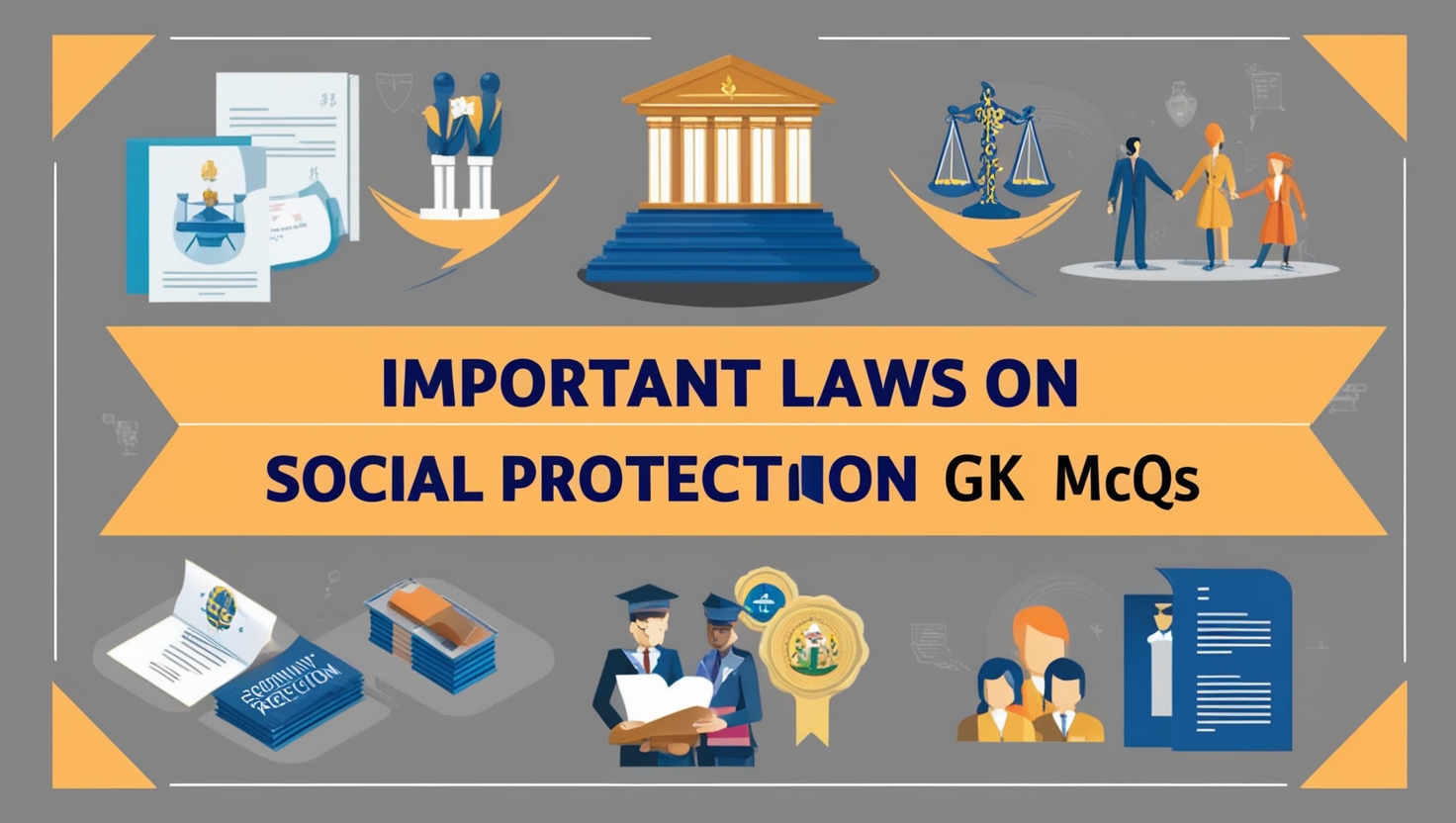
Discover the significance of social welfare in India through the Important Laws on Social Protection GK MCQs featured in this article. These multiple-choice questions are designed to enhance your understanding of the legal frameworks that support social protection.
Each question comes with detailed answers and explanations, making it an excellent resource for students, professionals, and anyone interested in the field. Prepare effectively and boost your knowledge with this essential collection!
1. In which year was the Rights of Persons with Disabilities Act passed?
- 2015
- 2016
- 2017
- 2018
Show Answer
Answer: 2016
The Rights of Persons with Disabilities Act, passed in 2016, was enacted to fulfill India’s obligations under the United Nations Convention on the Rights of Persons with Disabilities, which India ratified in 2007. This legislation aims to protect and promote the rights of persons with disabilities, including equal opportunities, non-discrimination, and full participation in society.
2. In which year was the Child and Adolescent Labour (Prohibition and Regulation) Act enacted?
- 1980
- 1982
- 1984
- 1986
Show Answer
Answer: 1986
The Child and Adolescent Labour Act of 1986 prohibits the employment of children and adolescents in any occupation or process, whether in private, government, semi-government companies, organizations, civil departments, or by their own families. It sets a minimum age limit for employment and aims to protect children and adolescents from exploitation in the labor market.
3. The Child and Adolescent Labour Act, 1986 prohibits employment of a child in any employment, including as domestic help, below which age?
- 12
- 13
- 14
- 15
Show Answer
Answer: 14
Under the Child and Adolescent Labour Act, 1986, the employment of a child, including as domestic help, is strictly prohibited below the age of 14 years. This legislation safeguards the rights and well-being of children by preventing their involvement in labor activities at a young age.
4. In which year was the Indecent Representation of Women Act passed?
- 1984
- 1986
- 1988
- 1990
Show Answer
Answer: 1986
The Indecent Representation of Women Act, passed in 1986, serves as a legal framework to prohibit indecent representation of women in various forms, including advertisements, publications, writings, paintings, and figures. This legislation is designed to prevent the objectification and exploitation of women in media and other public platforms.
5. In which year was the Model Tenancy Act passed?
- 2017
- 2018
- 2019
- 2020
Show Answer
Answer: 2019
The Model Tenancy Act, enacted in 2019, is aimed at reforming the tenancy market in India. It addresses issues related to housing deficits and aims to facilitate affordable and secure rental housing. The Act contributes to the government’s goal of providing housing for all by 2022.
6. In which year was the National Food Security Act passed?
- 2011
- 2012
- 2013
- 2014
Show Answer
Answer: 2013
The National Food Security Act, passed in 2013, is commonly known as the Right to Food Act. It focuses on providing subsidized food grains to the economically disadvantaged and aims to ensure food security for the vulnerable populations in India.
7. Which of the following are a part of the National Food Security Act, 2013?
1. Midday Meal Scheme
2. Integrated Child Development Service Scheme
3. Public Distribution System
Choose the right option:
- Only 1
- Only 1 & 2
- Only 2 & 3
- 1, 2 & 3
Show Answer
Answer: 1, 2 & 3
As part of the National Food Security Act, 2013, several schemes are included to address food security and related issues. These schemes encompass the Midday Meal Scheme, Integrated Child Development Service Scheme, and the Public Distribution System, all of which play a crucial role in ensuring access to food and nutrition for the underprivileged.
8. In which year was the Chhattisgarh Food Security Act passed?
- 2011
- 2012
- 2013
- 2014
Show Answer
Answer: 2012
The Chhattisgarh Food Security Act, enacted in 2012, was introduced to ensure that the people of the state have access to an adequate quantity of food and nutrition at affordable prices. The Act’s primary goal is to enable people to live with dignity by securing their food and nutritional requirements.
9. In which year was the Pre-Conception and Pre-Natal Diagnostic Techniques Act passed?
- 1992
- 1994
- 1996
- 1998
Show Answer
Answer: 1994
The Pre-Conception and Pre-Natal Diagnostic Techniques Act, passed in 1994, was introduced to curb female foeticides and address the declining sex ratio in India. This legislation regulates and restricts the use of pre-natal diagnostic techniques to ensure they are only employed for legitimate medical purposes.
10. According to the Pre-Conception and Pre-Natal Diagnostic Techniques Act, 1994, pre-natal diagnostic techniques like ultrasound and amniocentesis can be only used in which of the following cases?
1. Genetic abnormalities
2. Metabolic disorders
3. Chromosomal abnormalities
Choose the right option:
- Only 1
- Only 2 & 3
- Only 3
- 1, 2 & 3
Show Answer
Answer: 1, 2 & 3
According to the Pre-Conception and Pre-Natal Diagnostic Techniques Act, 1994, pre-natal diagnostic techniques like ultrasound and amniocentesis can be used in specific cases, such as diagnosing genetic abnormalities, metabolic disorders, and chromosomal abnormalities, provided they are used for medical purposes and not for gender determination.







